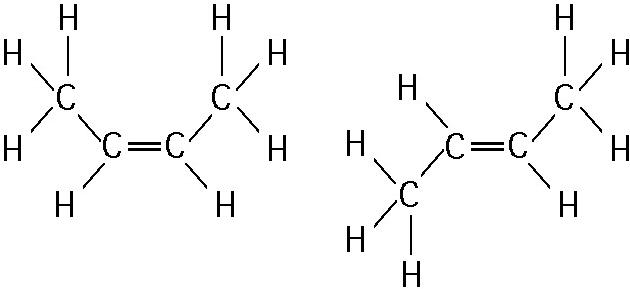
1) The two molecules shown in the figure above are best described
as
A) Structural isomers.
B) Radioactive isotopes.
C)
Enantiomers
D) Cis-trans isomers
Answer: D
2) Which of the following correctly describes any reaction that has
reached chemical equilibrium?
A) All of the reactants have been
converted to the products of the reaction
B) All of the products
have been converted to the reactants of the reaction
C) Both the
forward and the reverse reactions have stopped, with no net effect on
the concentration of reactants and the products.
D) The rate of
the forward reaction is equal to the rate of the reverse reaction
Answer: D
3) Which of the following statements is true about buffer
solutions?
A) They maintain a relatively constant pH when either
acids or bases are added to them
B) They maintain a constant pH
when acids are added to them but not when bases are added to
them
C) They maintain a constant pH when bases are added to them
but not when acids are added to them
D) They fluctuate in pH when
either acids or bases are added to them
Answer: A
4) In living systems molecules involved in hydrogen bonding almost
always contain either oxygen or nitrogen or both. How do you explain
this phenomenon
A) Oxygen and nitrogen are elements found in fats
and carbohydrates
B) Oxygen and nitrogen are elements found in
both nucleic acids and proteins
C) Oxygen and nitrogen were both
components of gases that made up the early atmosphere on Earth
D)
Oxygen and nitrogen are elements with very attractions for their electrons
Answer: D
5) About twenty-five of the ninety-two natural elements known to be
essential to life. Which four of these twenty-five elements make up
approximately 96 percent of living matter?
A) carbon, sodium,
hydrogen, nitrogen
B) carbon, hydrogen, nitrogen, oxygen
C)
carbon, oxygen, phosphorus, hydrogen
D) carbon, oxygen,
nitrogen, calcium
Answer: B

10) The molecule illustrated in the accompanying figure_____.
A)
is a saturated fatty acid
B) will be liquid at room temperature
C) stores genetic information
D) is a carbohydrate
Answer: B
11) Which of the following is the strongest evidence that protein
structure and function are correlated?
A) Enzymes tend to be
globular in shape
B) Denatured (unfolded) proteins do not
function normally
C) Proteins have four distinct levels of
structure and many functions
D) Proteins function best at certain temperatures
Answer: B
12) What is the difference between covalent bonds and ionic
bonds?
A) Covalent bonds involve the sharing of electrons between
atoms: ionic bonds involve the sharing of protons between charged
atoms
B) Covalent bonds involve the transfer of electrons between
charged atoms: ionic bonds involve the sharing of electrons between
atoms
C) Covalent bonds involve the sharing of pairs of electrons
between atoms: ionic bonds involve the sharing of single electrons
between atoms
D) Covalent bonds involve the sharing of electrons
between atoms: ionic bonds involve the electrical attraction between
charged atoms
Answer: D
13) Which of the functional groups below acts most like an acid in
water?
A) Hydroxyl
B) Amino
C) Carboxyl
D) Carbonyl
Answer: C
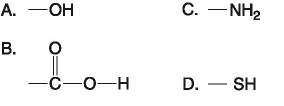
14) Which functional group shown above is a characteristic of
alcohols?
A) A
B) B
C) C
D) D
Answer: A
15) Which of the following includes all of the pyrimidines found in
RNA and DNA?
A) Cytosine and thymine
B) Cytosine, uracil and
guanine
C) Cytosine, uracil and thymine
D) Cytosine and uracil
Answer: C
16) Fluorine has an atomic number of 9. Which of the following would
you do to a neutral fluorine atom to complete its valence
shell?
A) Add 1 electron
B) Remove 1 electron
C) Add 2
electrons
D) Nothing. If fluorine is neutral, it has complete
valance shell
Answer: A
17) The element present in all organic molecules is_____.
A)
Hydrogen
B) Nitrogen
C) Carbon
D) Oxygen
Answer: C
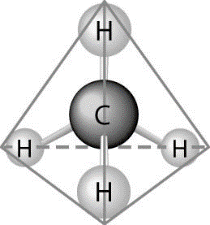
18) What causes the shape of the molecule shown above?
A) The
shape of the sp3 hybrid orbitals of the electrons shared between the
carbon and hydrogen atoms
B) The shape of the 1s orbital in the
carbon atom
C) The shape of the 2p orbitals in the carbon
atom
D) Hydrogen bonding configuration between the carbon and
hydrogen atoms
Answer: A
19) Why is carbon so important in biology?
A) It bonds to only a
few other elements
B) It has very little electronegativity,
making it a good electron donor
C) It can form a variety of
carbon skeletons and host functional groups
D) It is a common
element on earth
Answer: C
20) Which of the following is NOT a polymer?
A) Starch
B)
Cellulose
C) Glucose
D) DNA
Answer: C
21) Agrobacterium infects plants and causes them to form tumors. You
determine that tumor formation requires a large amount of the plant’s
energy for tissue formation. How might this change the number of
offspring a plant produces, and what is the most likely explanation
for this change?
A) The number of offspring should increase,
because in general, illness increases the reproductive output of
organism
B) The number of offspring should increase, because the
bacteria will provide energy for the plant
C) The should be no
effect of infection on offspring production because energy for
reproduction is independent of infection
D) The number of
offspring should decrease, because the plant will divert energy from
reproduction to tumor formation
Answer: D
22) A salamander relies on hydrogen bonding to stick to various
surfaces. Therefore, a salamander would have the greatest difficulty
clinging to a______.
A) Surface of hydrocarbons
B) Surface
of mostly carbon-nitrogen bonds
C) Slightly damp surface
D)
Surface of mostly carbon-oxygen bonds
Answer: A
23) Amino acids are acids because they always possess which
functional group?
A) Carboxyl
B) Amino
C)
Carbonyl
D) Phosphate
Answer: A
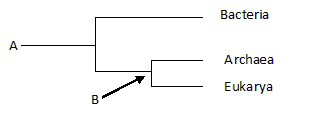
24) The phylogenetic tree below_____.
A) Includes noncellular life-forms
B) Depicts the three major
domains of life
C) Includes unicellular and some of multicellular
life, but not complex animals and plants
D) Includes unicellular
but not multicellular life
Answer: B
25) A carbon atom is most likely to form what kind of bond(s) with
other atoms?
A) Ionic
B) Hydrogen
C) Covalent
D)
Ionic bonds, covalent bonds, and hydrogen bonds
Answer: C
26) Which of the following types of cells utilize deoxyribonucleic
acid (DNA) as their genetic material but do not have their DNA encased
within a nuclear envelope?
A) Archaean
B) Fungi
C)
Animal
D) Plant
Answer: A
27) Why does ice float in liquid water?
A) The high surface
tension of liquid water keeps the ice on top
B) The crystalline
lattice of ice causes it to be denser than liquid water
C) Stable
hydrogen bonds keep water molecules of ice farther apart than water
molecules of liquid water
D) The ionic bonds between the
molecules in ice prevent the ice from sinking
Answer: C
28) The molar mass of glucose is 180 grams per mole (g/mol). Which of
the following procedures should you carry out make a 1 M solution of
glucose? Into 0.8 liter (L) of water, dissolve____.
A) 18g of
glucose and then add more water until the total volume of the solution
is 1L
B) 180g of glucose and then add 0.2L more of water
C)
1g of glucose and then add more water until the total volume of the
solution is 1L
D) 180g of glucose and then add more water until
the total volume of the solution is 1L
Answer: D
29) How does a scientific theory differ from a scientific
hypothesis?
A) Confirmed theories become scientific laws;
hypotheses become theories
B) Theories are proposed to test
scientific hypotheses
C) Theories are usually an explanation for
a more general phenomenon; hypotheses typically address more specific
issues
D) Hypotheses are usually an explanation for a more
general phenomenon, theories typically address more specific issues
Answer: C
30) If a DNA sample were composed of 10% thymine, what would be the
percentage of guanine?
A) 10
B) 40
C) 80
D) It is
impossible to tell from the information given
Answer: B
31) The atomic number of chlorine is 17. The atomic number of
magnesium is 12. What is the formula for magnesium chloride?
A)
MgCl
B) Mg2Cl
C) MgCl2
D) MgCl3
Answer: C
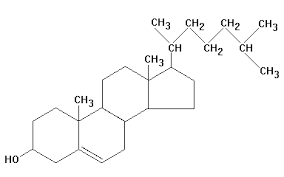
32) The molecule shown the accompanying figure is a _____.
A)
Steroid
B) Protein
C) Fatty acid
D) Phospholipid
Answer: A
33) You find yourself standing next to a beautiful rose bush. Which
of the following do you and the rose have in common?
A) You and
the rose have nothing in common
B) You both are
multicellular
C) You are both prokaryotic
D) You both lack a
membrane-bound nucleus
Answer: B
34) The experimental approach taken in current biological
investigations presumes that____.
A) A living organism can be
understood in terms of the same physical and chemical laws that can be
used to explain all natural phenomena
B) A life force ultimately
controls the activities of living organisms and this force cannot be
studied by physical or chemical bonds
C) Living organism are
composed of the same elements present in nonliving things, plus a few
special brace elements found only in living organism or their
products
D) Simple organic compounds can be synthesized in the
laboratory from inorganic precursors, but complete organic compounds
like carbohydrates and proteins can be synthesized only by living organisms
Answer: A
35) Which level of protein structure do the a-helix and the B-pleated
sheet represent?
A) Primary
B) Secondary
C) Tertiary
D) Quaternary
Answer: B
36) Increased atmospheric CO2 concentrations might have what effect
on seawater?
A) There will be no change in the pH of seawater,
because carbonate will turn to bicarbonate
B) Seawater will
become more acidic, and carbonate concentrations will decrease
C)
Seawater will become more alkaline, and carbonate water concentrations
will decrease
D) Seawater will become more acidic, and carbonate
concentrations will increase
Answer: B
Use the following information when answering the corresponding
question(s).
In 1668, Francesco Redi performed a series of
experiments on spontaneous generation. He began by putting similar
pieces of meat into eight identical jars. Four jars were left open to
the air, and four were sealed. He then did the same experiment with
one variation: Instead of sealing four of the jars completely, he
covered them with gauze (the gauze excluded the flies while allowing
the meat to be exposed to air). In both experiments, he monitored the
jars and recorded whether or not maggots (young flies) appeared in the
meat.
37) Refer to the paragraph on Redi’s experiments. What
hypotheses was being tested in the initial experiment with open versus
sealed jars?
A) Spontaneous generations can occur only if meat is
exposed to air
B) Spontaneous generations is more likely during
the long days of summer
C) Maggots do not arise spontaneously,
but from eggs laid by adult flies.
D) The type of meat used
affects the likelihood of spontaneous generations
Answer: C
38) Why are hydrocarbons insoluble in water?
A) The majority of
their bonds are nonpolar covalent carbon-to-hydrogen linkages
B)
The majority of their bonds are polar covalent carbon-to-hydrogen
linkages
C) They are less dense than water
D) They exhibit
considerable molecular complexity and diversity
Answer: A
39) Which of these provides evidence of the common ancestry of all
life?
A) Structure of cilia
B) Stricture of nucleus
C)
Structure of chloroplasts
D) Near universality of the genetic code
Answer: D
40) Which polysaccharide is an important component in the structure
of many animals and fungi?
A) Cellulose
B) Amylose
C)
Amylopectin
D) Chitin
Answer: D
41) Which type of bond must be broken for water to vaporize?
A)
Hydrogen bonds
B) Both polar covalent bonds and hydrogen
bonds
C) Polar covalent bonds
D) Ionic bonds
Answer: A
42) If the cytoplasm of a cell is at pH 7, and the mitochondrial
matrix is at pH 8, then the concentration of H+ ions_______.
A)
In the cytoplasm is 8/7 the concentration in the mitochondrial
matrix
B) Is 10 times higher in the cytoplasm than in the
mitochondrial matrix
C) In the cytoplasm is 7/8 the concentration
in the mitochondrial matrix
D) Is 10 times higher in the
mitochondrial matrix than in the cytoplasm
Answer: B
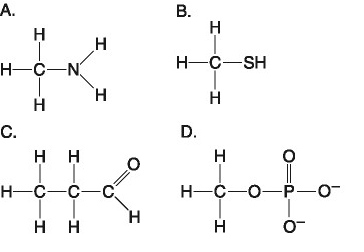
43) Which molecule shown above contains an amino acid functional
group, but is NOT an amino acid?
A) A
B) B
C) C
D) D
Answer: A
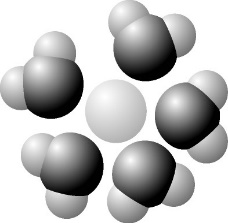
44) Based on your knowledge of the polarity of water molecules, the solute molecule depicted here is most likely_______.
A) Nonpolar
B) Negatively charged
C) Without
charge
D) Positively charged
Answer: D
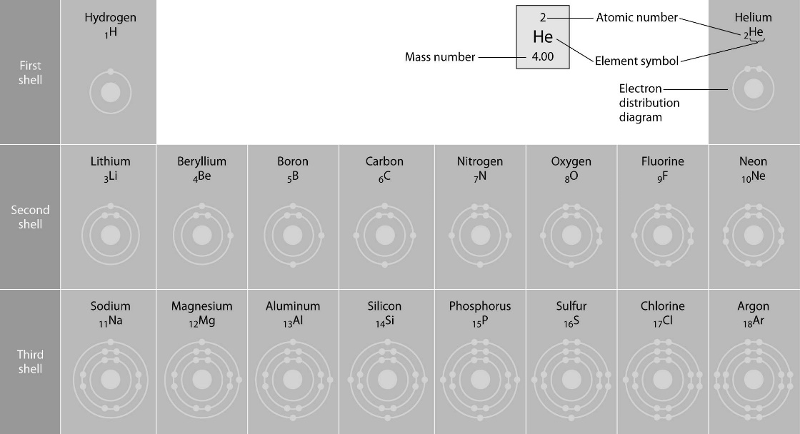
45) Refer to the figure above (first three rows of the periodic
table). What element has properties most similar to carbon?
A)
Silicon
B) Boron
C) Nitrogen
D) Phosphorus
Answer: A
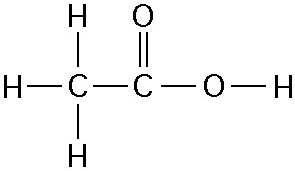
46) One mole of the compound above would weigh how many grams? (Note:
The atomic masses, in daltons, are approximately 12 for carbon, 1 for
hydrogen, and 16 for oxygen.)
A) 29
B) 150
C)
60
D) 30
Answer: C
47) Normal hemoglobin is a tetramer, consisting of two molecules of B
hemoglobin and two molecules of a hemoglobin. In sickle-cell disease,
as a result of a single amino acid change, the mutant hemoglobin
tetramers associate with each other and assemble into large fibers.
Based on this information alone, we can conclude that sickle-cell
hemoglobin exhibits______.
A) Only altered primary
structure
B) Only altered tertiary structure
C) Only altered
quaternary structure
D) Altered primary structure and altered
quaternary structure; the secondary and tertiary structures may or may
not be altered
Answer: D
48) A controlled experiment_______.
A) Includes at least two
groups, one differing from the other by two or more variables.
B)
Includes one group for which the scientist controls all
variables
C) Is repeated many times to ensure that the results
are accurate
D) Includes at least two groups, one of which does
not receive the experimental treatment
Answer: D
49) Which of these is an example of inductive reasoning?
A)
These organism live in sunny regions. Therefore, they are using
photosynthesis
B) In two species are members of the same genus,
they are more alike than each of them could be to a different
genus
C) Hundreds of individuals of a species have been observed
and all are photosynthetic; therefore species is
photosynthetic
D) If protists are all single-celled, then they
are incapable of aggregating
Answer: C
50) Hydrophobic substance such as vegetable oil are_____.
A)
Nonpolar substance that have attraction for water molecules
B)
Polar substances that repel water molecules
C) Polar substances
that have an affinity for water
D) Nonpolar substance that repel
water molecules
Answer: D